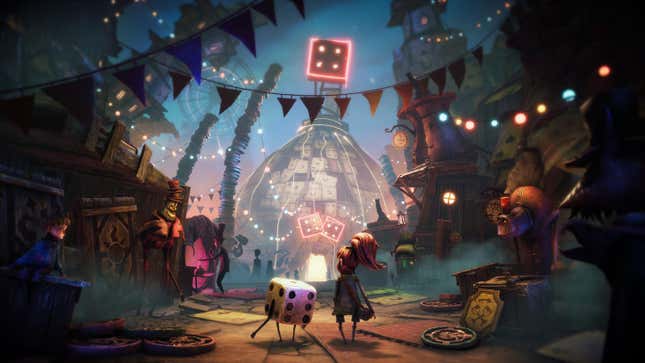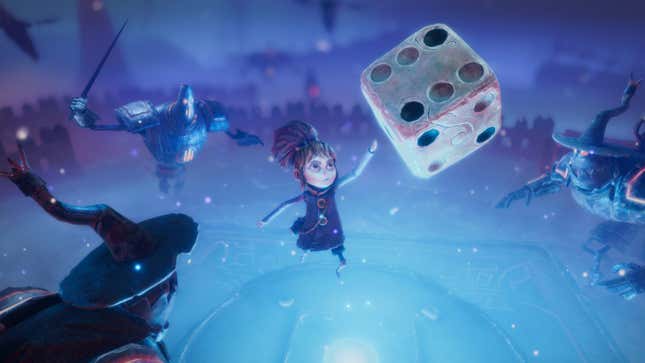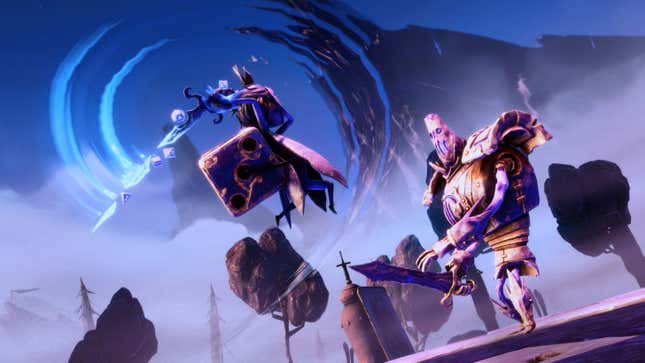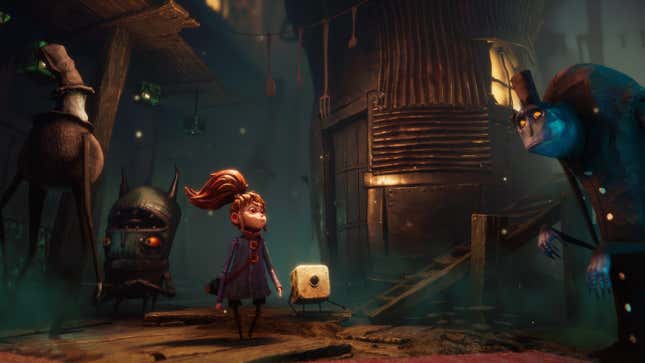
“Random rules! Random rules!”
That’s a refrain in Lost in Random, an action-adventure game (of sorts) and one of the more fascinating under-the-radar releases of 2021. Like much of the game, the phrase comes hitched with a double meaning. You see, Lost in Random takes place in a fantasy world where many outcomes are governed by chance. But also, the kids in that world love to play games, and they insist on playing by a randomized ruleset.
The game takes place in the fictional, Tim Burton-esque Kingdom of Random—itself broken up into six smaller realms, tiered in terms of status. When children turn 12, they roll a die, and whatever number they get dictates where they’ll live for the rest of forever: a one lands them in the downtrodden Onecroft; a two in Two-Town, where every citizen has a bisected personality; a three in the war-torn Threedom; and so on. The lucky kids who roll a six get whisked away to the supposedly glimmering Sixtopia.
“If you have a really strong theme and you kind of shoot your ideas through that prism, even though how weird it all seems, it kind of connects in an odd, underlying way,” Olov Redmalm, game director of Lost in Random, told Kotaku in a Zoom interview. “There’s always the common theme of randomness, or dice, that ties everything together.”
Lost in Random, which came out last month for most platforms, is the latest by the Swedish-based indie outfit Zoink (best known for developing 2017’s Fe). It takes that driving ethos—the commonality of randomness—and runs with it.

At the start of the game, the main character, Even, is separated from her sister, Odd, who rolls a six. You’re placed in Even’s shoes, and spend the game trying to reunite. In short order, you meet a sentient six-sided die—called Dicey—that boasts magical powers and speaks in total gibberish. Inexplicably, Even is able to understand Dicey’s musings, much as how certain Star Wars characters can understand certain others, whose dialogue remains unparseable to the audience.
“There’s a lot of R2-D2 in Dicey, of course,” Klaus Lyngeled, CEO of Zoink and a co-director of Lost in Random (alongside Redmalm), told Kotaku. “And Chewbacca, too.”
Oh, and fun fact: Redmalm provided the voice for Dicey. For one of the game’s early demos, he told Kotaku, Redmalm recorded a placeholder track of gibberish. Throughout the development process, nobody bothered changing it. So they kept him in the role.
“I didn’t want to put that on another actor. Oh, like, ‘Can you do…?’” he said, mimicking—perhaps unintentionally—the haywire arm movements Dicey so frequently exhibits in the game.
Plus, voicing Dicey gave Redmalm a bit more creative leeway over the character, whom he helped write for as well, allowing him to sneak in small Easter eggs. Listen closely, and you may hear Dicey say, “Wubba lubba dub dub,” a phrase often spoken by characters from the cartoon show Rick & Morty.
More than just a bit part, Dicey also serves as the key to Lost in Random’s inventive battle system, which is initially befuddling, but quickly makes sense after a battle or two. Here’s how it works:
- Initially, Lost in Random battles look like typical third-person action combat. As Even, you shoot enemies with your slingshot. This doesn’t deal any damage, but it does dislodge crystals that are embedded in your foes.
- Collecting crystals fills up Dicey’s energy meter.
- When that’s full, you can throw Dicey—yes, in this game, you frequently toss your trusty sidekick—as if you were rolling a die. If you roll a one, you get one point to spend; a two gives you two points; and so on. This action also freezes time.
- While time is frozen, you draw five cards from your deck (which can hold up to 15 cards total). You’ll be able to play cards based on how many points you’ve earned from throwing Dicey. Some cards, like a basic sword or health potion, cost one point. Stronger cards cost more; a bomb runs you two points, while a battleaxe will cost you three.
- Once you’ve spent all your points, you can unfreeze time and see your turn play out. If you played, say, a bow-and-arrow card, you’ll now have a bow in your hand plus 10 arrows. If you played a time trap card, the area you’ve designated as a trap will slow motion for ten seconds.
- In that instance, after you’ve spent your arrows and after the time trap expires, you repeat the cycle. There are dozens of cards in the game, countless combinations. You can see how the possibilities can spiral out of predictability. Random rules, after all.

The stop-go nature gives a turn-based structure to what’s ostensibly standard action combat. Redmalm likens it to Baldur’s Gate, “where you take your time to put out these traps and skills and then you hit unpause and a fireball shoots and everything just blows up. It’s fun to fail—at least I think so.”
Lyngeled pointed out how the combat is inspired by board games. Key battles in Lost in Random are structured so you have to move a token along a predetermined path all the way to the end, kind of like a gothic-inspired Candy Land. They’re a bit like regular battles, except to proceed you need to pull the bonus card from your deck that allows you to move your board piece another spot forward. If the card doesn’t show up, you have to build up Dicey’s energy again to roll another hand of cards and try again..
“In a board game, you have to wait for your turn,” Lyngeled said, explaining how they wanted to capture this spirit in the game.
That board games wrapped in a folkloric canon play such a role in Lost in Random only heightens its Burton-esque fairy tale bona fides, which are plainly evident in the art direction. “I’m an old Tim Burton fan,” Lyngeled said. “Obviously, the stuff that he’s done lately is quite crap, but stuff he did in the beginning was quite nice, you know?”
But it’s more than just The Nightmare Before Christmas: The Game, as Lost in Random taps influences from beyond Hollywood, including from Swedish folklore, and artwork by the Australian collage artist Shaun Tan. Throw in a zippy script, written in part by the Toronto-based writer Ryan North, and what you get is the feeling that you’re playing through, if not a movie, a television show with eye-popping production values.
By the way, that’s possibly in the cards, Redmalm and Lyngeled told me. Yes, touchstone franchises like Uncharted and Sonic the Hedgehog get licensed for splashy tentpole adaptations, but there’s a recent trend of smaller games getting optioned, as well. Just this month, the production company dJ2 Entertainment secured rights to produce adaptations of Sable and Night Call, both published by Raw Fury. Legendary Television is working on a small-screen version of Life is Strange. And even System Shock, hailing from the ‘90s, is in the works at the streaming service Binge. Don’t be surprised if Lost in Random shows up among a list of forthcoming projects some day.

Having played, it’s certainly a world I’d love to see more of, no matter the medium. The 12 or so hours it takes to finish might feel brief, but there’s a lot of meat on its bones. It turns out, there was almost much, much more.
At one point, there was a chess-like component, where in some battles you’d have to use Dicey to move pieces on a chessboard, all while fighting off enemies. At another, you’d face off against an opponent who’d also have a gibberish-sputtering dice friend. (No notion of multiplayer, though, the guys told me.) One kernel of particular ingenuity had you go into Dicey, whereupon you’d find a whole other world. Lyngeled said the team considered treating Dicey’s insides like “kind of a safe haven or almost like your own Normandy ship,” referencing the home base from BioWare’s venerable trilogy of Mass Effect games.
I’ll just say this: Keeping it simple works in the game’s favor. There’s enough novelty to make Lost in Random feel like nothing you’ve ever played before. And there’s still that throughline of unpredictability. You can stack your deck with powerful cards all you want, but if Dicey’s rolls don’t land in your favor, you’re screwed. Random, folks—it’s the rules, and it seriously rules.
“We still wanted to keep that fun chaos,” Redmalm told me. “Even when [things] go bad, it should feel cool.”





